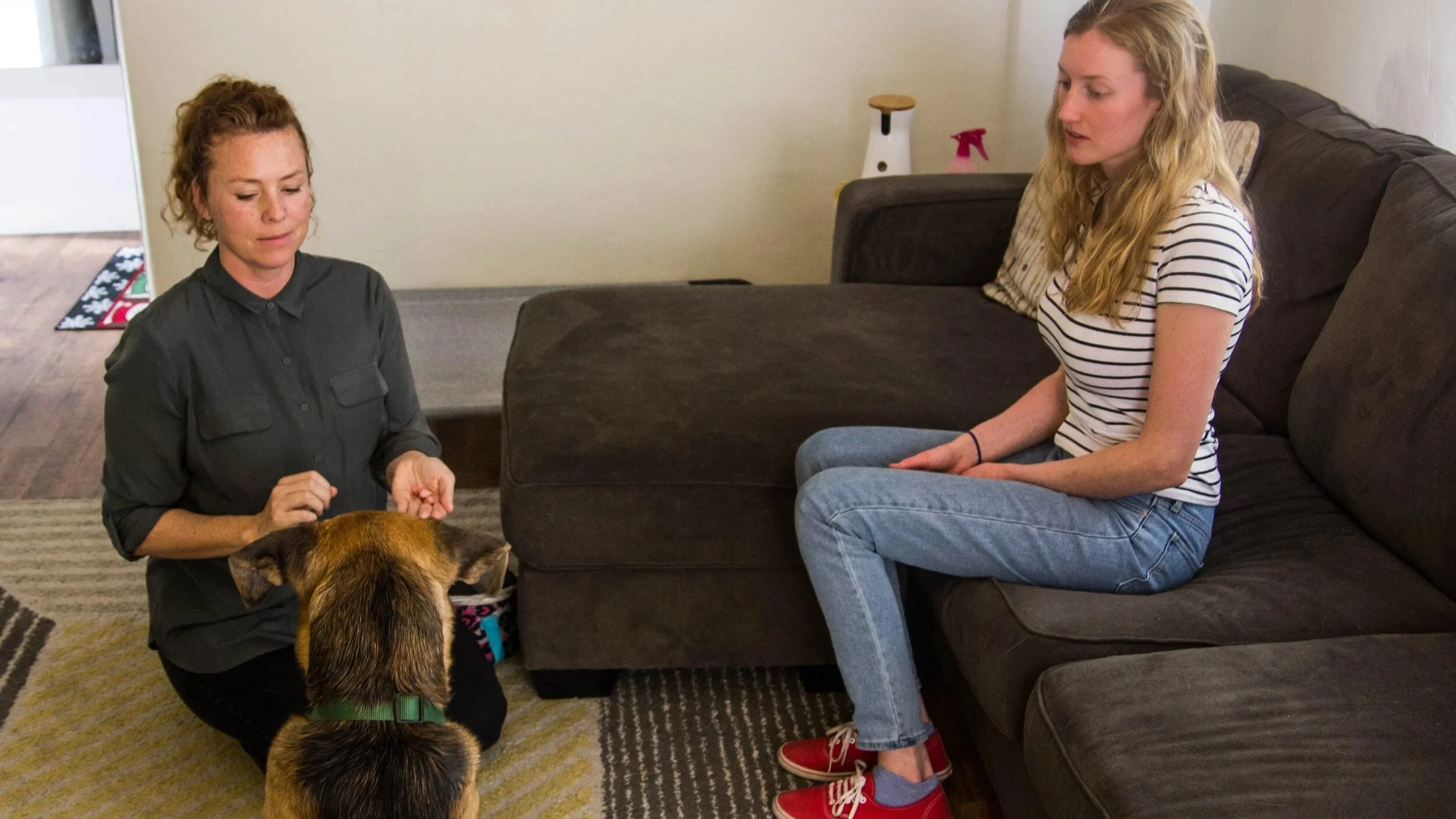Board-and-Train vs. Private Lessons: What Actually Helps Most Dogs Learn
At some point, every dog parent hits the wall: you’ve tried YouTube tips, a pocketful of treats, and your firmest “no”—but the leash pulling, guest-jumping, or barking when you leave still happens. It’s frustrating, because you love your dog, and the gap between what you’re teaching and what they’re doing feels… wide.
So the question comes up: should you send your pup away for an intensive board-and-train program, or work with a trainer through private lessons where you learn alongside your dog?
Both can help. One may simply fit your dog, home, and schedule better than the other. Let’s break down how dogs actually learn, where each approach shines, and how to choose with confidence.
How Dogs Actually Learn (and Why “Transfer” Matters)
Dog training isn’t magic—it’s learning science. Most of the skills dog parents care about—like loose-leash walking, calm greetings, and reliable recall—are shaped through operant conditioning. This is a type of learning where a dog connects their voluntary behavior with its consequences. Behaviors followed by good outcomes are reinforced and become more likely, while those followed by unpleasant outcomes tend to fade.
In plain terms: you get what you reinforce.
That’s why veterinary behaviorists and universities consistently recommend reward-based plans. Using treats, toys, play, and praise helps dogs learn effectively while also protecting their well-being and trust in you. (UC Davis Vet Med has a quick primer showing how simple it is to start rewarding the right behaviors at the right time.)
But there’s another crucial piece: generalization. Dogs don’t automatically “know” a behavior applies in every situation. A sit in your kitchen doesn’t guarantee a sit on a noisy sidewalk. Skills stick best when practiced in real-life contexts—your doorway, the park you visit, around your kids, or near that one noisy neighbor—and when the person who will give the cue (usually you) does the repetitions.
This is where owner involvement becomes essential, especially with board-and-train. Even if your dog learns beautifully with a trainer, the behavior has to transfer to the home environment. Without that transfer, progress often unravels—your dog may sit instantly for the trainer but look confused when you ask. Dogs learn through repetition in context, not by “general rule.”
If you choose board-and-train, think of it as laying groundwork, not outsourcing the whole process. The handoff is where the real work begins:
You learn the cues and timing the trainer used, so your dog recognizes and responds to you.
You practice in your own environment, where the distractions and routines are unique.
You follow through consistently, so reinforcement patterns match what your dog practiced during training.
Finally, a quick note on method. A large body of research cautions against aversive techniques (shock/e-collars, prong corrections, intimidation). They can suppress behavior temporarily but often come at a cost to welfare, learning, and trust. The American Veterinary Society of Animal Behavior’s position statement explicitly recommends reward-based approaches, and numerous studies link aversive methods with stress and poorer outcomes compared with positive reinforcement.
Board-and-Train: The Upsides—and the Caveats
What it is: Your dog stays with trainers for a set period, practices daily, and returns home with a “handoff” session. The appeal? Intensive structure, faster foundations, and less daily work for you up front.
Where it helps: Foundation manners (settle on a mat, polite door greetings, crate comfort) and calm routines can improve quickly in a controlled setting.
Bonus benefit: If your dog’s behavior is creating tension at home—constant leash pulling, door-darting, or guest-jumping—a board-and-train program can act as a “reset button.” It gives you a short break from the stress while basic skills are reinforced by professionals, and allows you time to learn a plan for building positive routines with your dog once they return.
The catch: Long-term success depends on what happens at home—your timing, your consistency, and your practice. Without that follow-up, results fade.
What to vet carefully:
Methods: Avoid programs that use shock collars, prongs, or intimidation. Research shows they cause stress and don’t produce better results than reward-based training.
Owner lessons: Look for multiple transfer sessions before and after, plus videos of your dog in training and a written home plan.
Fit for the dog: For separation anxiety or distress when alone, board-and-train is often counterproductive. Those issues improve through gradual, at-home practice—not sudden, prolonged absences.
Bottom line: A quality board-and-train can jump-start skills, act as a short-term reset for a stressful household, and provide structured practice—but it should always be transparent, humane, and paired with solid owner coaching.
Private Lessons: When Coaching Beats Outsourcing
What it is: You and a dog trainer work together—virtually or at home—on the exact issues you face in the real places they happen. You get a plan, live feedback, and homework that fits your schedule.
Why it works: Private coaching builds your skills—how to mark behaviors, deliver rewards at the right moment, set up easy wins, and add challenges step by step. Since practice happens in your dog’s everyday environment, generalization happens faster: “Oh, sit means sit right here on our block, near that same mail truck.”
Where it shines:
Leash reactivity: You practice mechanics on your own routes, adjusting rewards for real-life triggers, and learn how to keep your dog under-threshold, an essential ingredient to successfully helping your dog overcome leash reactivity.
Jumping on guests: You rehearse calm greetings with actual visitors. (If you want a simple at-home routine to pair with coaching, this primer on how to train a dog not to jump is a good companion read.)
Separation anxiety: Progress comes from methodical, bite-sized absences tailored to your dog’s threshold. That sort of work fits poorly into a send-away model and better into a coached, at-home plan—see separation anxiety training for what that structure looks like in practice.
Aggression Treatment: Aggressive behaviors such as barking and lunging at guests who stop by or resource-guarding of food, toys, and places of rest are best handled in the home environment, where and when the behavior occurs.
What to expect: Instead of outsourcing all the reps, you’ll put in short daily sessions (even 10–15 minutes makes progress). Success is measured in real-life wins: fewer leash yanks, quicker mat settles, longer calm alone time.
Making the Call: A Simple Way to Choose
Ask yourself: Where does this behavior happen, and who needs to manage it?
If the answer is “in my home, with me,” private coaching usually delivers the most durable change—especially for context- or emotion-driven issues like reactivity, barking at household noises, or separation anxiety.
If your dog’s behavior is creating household tension, a short-term board-and-train can also serve as a “reset button,” giving you a break from stress while basic foundation skills are reinforced by professionals. But for long-term success, you still need to learn alongside your dog and practice the new skills at home.
If you’re leaning toward a board-and-train program, make sure you clarify:
Methods: Are they using reward-based techniques aligned with veterinary behavior recommendations? If the trainer cannot explain their methods or tells you they will be using an e-Collar or choke chain to train your dog, that is a really bad sign.
Owner handoff: How many transfer sessions are included, and will you receive written instructions or a video of your dog’s progress?
Real-life proofing: Will your dog’s training include the actual environments, triggers, and routines you encounter at home?
Prefer to keep it simple? Start with private lessons. You can always add a short, focused board-and-train later if your coach recommends it. And if you do try board-and-train, plan for follow-on coaching sessions so new skills truly transfer to your home environment rather than staying confined to the training facility.
Conclusion
If your goal is a dog who behaves reliably in your life, owner coaching tends to win. Board-and-train can jump-start skills, help reset a tense household, and provide structured practice—but the most lasting results happen when you learn the cues, practice in your home environment, and consistently reinforce behaviors.
Choose the path that builds your skills, uses humane methods, and focuses on real-world results. With the right plan, your dog won’t just perform on command—they’ll truly understand what you’re asking in the situations that matter most.



